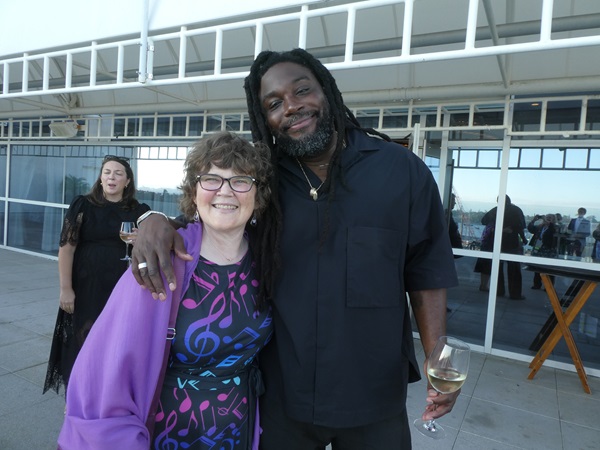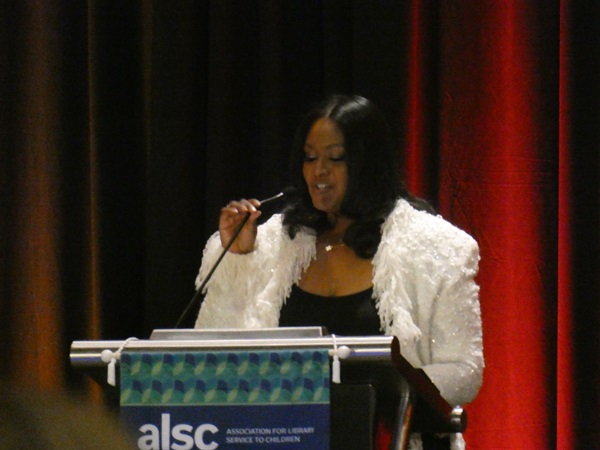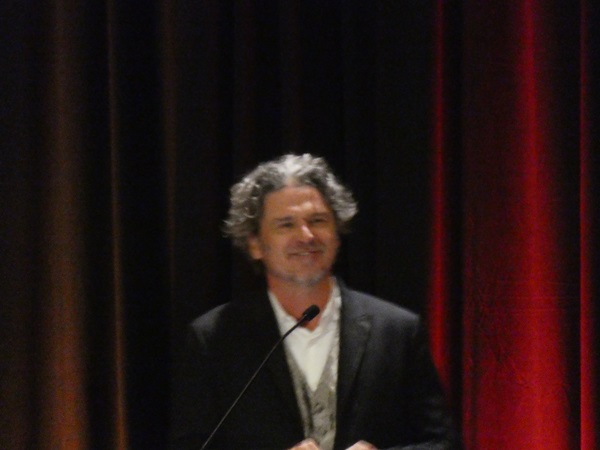Sunday night of ALA Annual Conference is time for the Newbery/Caldecott/Legacy Banquet!
Beforehand, there was a big balcony to hang around outdoors in the breeze – and I got to talk with friends – and author Jason Reynolds!
The Newbery Banquet is always a wonderful chance for a grand celebration with fellow children’s book lovers. There’s always an amazing program with art from the Caldecott medalist, good food, and then the highlight of the night – speeches from the winners. Since I knew the speeches get printed in Horn Book Magazine, I held off from taking notes and just enjoyed the moment this year. I will consult said magazine for some of the highlights from the speeches.
First, the Caldecott Honor winners get to receive their award without having to give speeches. Then the first speech came from Vashti Harrison, Caldecott Medalist for her amazing picture book, Big.
Vashti Harrison began her speech by remarking that people told her right away she was the first Black woman to win the Caldecott Medal. And then she told us about seven Black women who had won Caldecott Honor: Faith Ringgold, Carol Byard, Ekua Holmes, Oge Mora, Cozbi A. Cabrera, Noa Denmon, and Janelle Washington.
Then she talked about her own story. For anyone who’s read the amazing book Big, it wasn’t a surprise, because she portrayed all of this with her art. But she did talk about coming to illustration in film school with animation, drawing Disney-style people who didn’t look like herself. Even as a child, she drew characters thinner than herself, and the images she tended to copy were mostly of white or light-skinned women.
She was empowered to draw beautiful Black women, and got love and support online, but she was still making them impossibly thin.
I love this part of her speech so much, I’ll copy it here:
I resolved to only draw children, children who are allowed to be chubby and chunky and thick, and we love them for it. Children, who have no wrong or incorrect curves or folds. Children, for whom big is good.
Drawing is such an intimate practice. You spend time with characters, you make decisions that seem microscopic but can change a character entirely: the placement of their eyes, the length of their neck. As I made these tiny creative choices, I wondered, At what age does big start being bad? For me it was in second grade, when a girl looked over at my round belly and asked if I was pregnant. That version of me is still inside, still hurting.
I needed to make something to heal myself, and I needed to confront my internalized bias.
And she succeeded! She went on to talk about adultification and Black girls being punished for being too much. Her book takes those on so beautifully.
It was amazing to be in the room when she received this well-deserved medal for creating the most distinguished American picture book of 2023.
Then came the Newbery! First all the wonderful Honor book authors received their plaques. Then came the presentation of the Newbery Medal to winner Dave Eggers, for his book The Eyes and the Impossible.
He began his speech with a delightful story of his first grade teacher helping all her students write books, telling us that great educators expect more of us. And then his fifth grade teacher did the same thing – and entered his story in the state young authors’ contest, and he was chosen to attend a celebration of young authors in another part of the state.
At that conference, he met Gwendolyn Brooks, who called the students “fellow authors.” He was never the same.
His parents died at the ages of fifty-one and fifty-five, and he is now fifty-four. He’d made a vow to himself that if he lived past fifty, he’d write whatever he wanted. I like this paragraph from his speech:
My secret that I can now divulge is that The Eyes and the Impossible was my love letter to being alive past fifty, and how I sometimes cannot believe my luck. To see what I see, to love who I love, to be able to convey these things in a book that I honestly cannot believe made any sense to anyone. This is the most personal book I’ve ever written, and it’s also the weirdest, and the fact that librarians of this great nation have recognized it – that word again! – means to me, and should mean to any writer anywhere, that if we forget our dignified selves and write with a kind of untethered abandon, sometimes that’s exactly what a reader wants. Johannes, the protagonist of this book, gave me a way to write the way I always wanted to write – actually sing the way I always wanted to sing – and the fact that you all have accepted his voice, as unbridled as it is, means the world to me. I thank you.
And I have to add his last two paragraphs where he thanks librarians:
Thank you, the Newbery committee. I can’t imagine how hard your work was, but I am grateful to you, and to all librarians everywhere, for accepting this very strange book, and for accepting all very strange books. Books are simply souls in paper form, so when we accept a strange book, we accept a strange soul. We say that soul, however unusual or unprecedented, how reckless or flawed, belongs among the other souls of the world. And once this soul has been welcomed to the library – which is nothing less than a repository of souls – it cannot be unwelcomed.
More than that, because of you, these souls will be protected. When the small-minded ban books, they are banning souls. They are removing certain voices from the chorus of humanity and the chorus of history. And it is librarians who are tasked with making sure these souls are not removed, that they always have a home and always have a voice. Librarians are the keepers and protectors of all history’s souls, its outcasts and oddballs, its screamers and whisperers, all of whom have a right to be heard. No pressure, but we count on you to save us all, to protect us all, to preserve us all. Thank you and godspeed.
The final award of the night was the Children’s Literature Legacy Award, given to Pam Muñoz Ryan. She gave another lovely acceptance speech.
She began her speech with thanks to the many, many people who have helped her along in her career. Then she talked about how when she started writing, “there were only a handful of stories written by and about Latinos in the United States.” Her book Esperanza Rising parallels her grandmother’s experiences in a Mexican farm labor camp, and that camp is where her mother was born.
She didn’t grow up in a print-rich environment, but both her her grandmothers nurtured her love of story. The small branch library near her house fanned that love into an obsession with reading. She went there to escape from younger siblings and cousins and to get out of the heat.
It was inevitable that, sooner or later, the books would leap from the confines of the stacks and hold me spellbound. Stories are powerful that way, and once I was captured, I carried books to kitchen tables, to the car, and secretly propped them inside textbooks at school. I tried on many lives far more interesting than my own.
As I made my way through junior high, books carried me away from the wrath of mean girls, tallness, big feet, and a big, noisy extended family. I coped through books. It is no surprise that I now often write for readers who are the same age that I was when books made the most profound difference in my life.
She talked about seeing the worth inside each other, as her grandmother did, and she told a story about Pablo Neruda from her book The Dreamer, when he exchanged gifts with a child he didn’t know through a hole in a fence.
As artists and writers, we pass our work through a hole in the fence, never knowing who is on the other side. Never knowing if or when someone might pick up our book and have a reaction, a revelation, a good laugh, or the clutching-to-the-chest moment of a book well-loved and long-carried. We’re never sure if we will incite our reader, cause an indignant rampage, or inspire a cult following. We write and draw, shackled to the beautiful tyranny of now. We work with hearts full of hope for the future, and the promise of unknown communions.
Once again, it was thrilling to be in the giant room with these brilliant creators doing great things for children along with hundreds of other people celebrating distinguished children’s books.



